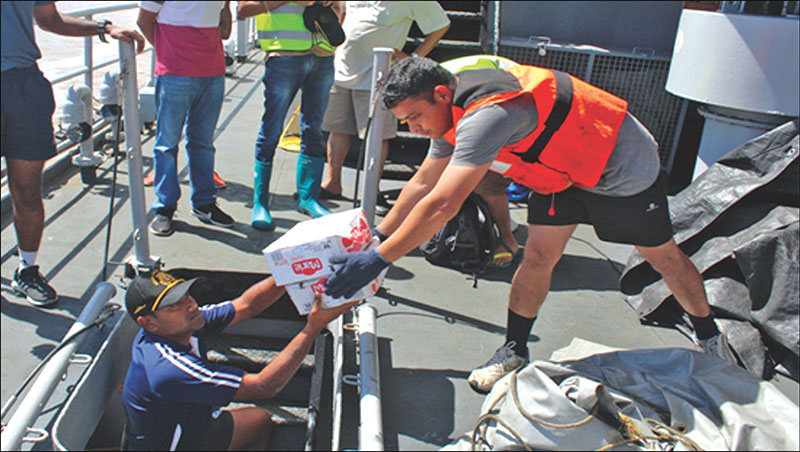Indian Navy’s efforts go beyond the nation’s shores when it comes to HADR
Yunus Dar
The Indian Navy is the first responder to much of the territory in the Indian Ocean Region (IOR). The IOR is one of the high-risk regions where disasters tend to take place. And since the maritime capacities of most littoral nations around IOR are not adequate to individually cope with catastrophic disasters in such a vast ocean, the Indian Navy plays a prominent role.

The IOR stands significantly exposed to a wide-ranging natural disasters. In India, 58.6 per cent of the landmass is prone to earthquakes of moderate to very high intensity; over 40 million hectares (12 per cent of land) is prone to floods and river erosion; of the 7,516 km long coastline, close to 5,700 km is prone to cyclones and tsunamis. As such quick access, mobility, availability of the desired relief material and medical care are some of the key factors that define the Indian Navy’s role in relief operations.
The concept of mission-based deployments, according to the Indian Navy, involves deploying mission-ready ships and aircraft along critical sea lanes of communications (SLOC) and chokepoints, always ready to meet any eventuality across the spectrum of operations ranging from acts of maritime terrorism and piracy to Humanitarian Assistance and Disaster Relief (HADR) missions. These deployments are aimed to be maintained 24/7 and round the year with ships being sustained and turned around on station.
During the devastating tsunami in 2004, the Indian Navy played a prominent role in the HADR operations, being one of the first responders to the crisis. During ‘Operation RAHAT’ in April 2015, the Indian Navy rescued hundreds of Indian and foreign citizens from Yemen taking them to safer areas. When cyclone Roanu struck Bangladesh in 2016, the navy was at the forefront of HADR operations, bringing relief to lakhs of stranded people. Bangladesh was also badly hit by cyclone Mora in June 2017, and again, the Indian Navy played an instrumental role in the relief operations in the country. The Indian Navy has played prime role in many humanitarian crisis situations in the countries bordering the Indian Ocean, upholding the slogan of ‘SAGAR (Security and Growth for All in the Region).’
Recent HADR operations
Cyclone ‘IDAI’ in Mozambique
The ships of First Training Squadron of the Indian Navy operating in the Southern Indian Ocean were diverted to Port Beira, Mozambique based on a request received from the government of Mozambique to provide HADR to the local population post the devastation caused by cyclone ‘IDAI’ which struck the coast of Mozambique on 15 March 2019. INS Sujata, ICGS Sarathi and INS Shardul provided necessary support to the local administration. Cyclone ‘IDAI’ made landfall at Beira, Mozambique causing widespread damage and loss of human life in the central and northern provinces of the country. The Indian Navy ships setup medical camps and provided food, water, blankets and other necessary relief items, as required by the local authorities. The Indian Navy rescued more than 192 people in the process, providing assistance to 1,381 people. Chetak helicopter undertook several sorties to facilitate aerial survey of the affected areas, working with the Mozambique authorities. The Indian Navy’s assistance was in line with its reputation of the regional net security provider, helping the nation bolster its ties with Africa.
Cyclone Fani
As the severe cyclone Fani made its landfall in May 2019, the Indian Navy got into action deploying significant inventory of its assets in the HADR operations. The Eastern Naval Command (ENC) pressed four warships including an anti submarine warfare (ASW) corvette into action, accompanied by four multi-utility helicopters into rescue and relief operations.
Indian naval ships at Visakhapatnam and Chennai proceeded to the affected areas to undertake relief operations and evacuation, providing logistic support including medical aid. These ships embarked with additional divers, doctors, inflatable rubber boats and relief material that included food, tents, clothes, medicines, blankets, etc., in sufficient quantities. Naval aircraft were kept at standby at the Naval Air Stations INS Rajali at Arakkonam, Tamil Nadu and INS Dega at Visakhapatnam, Andhra Pradesh to undertake reconnaissance, rescue, casualty evacuation and air drop of relief material to the stranded if required. Two maritime recce sorties were undertaken by the Dornier aircraft of the navy.
You must be logged in to view this content.

